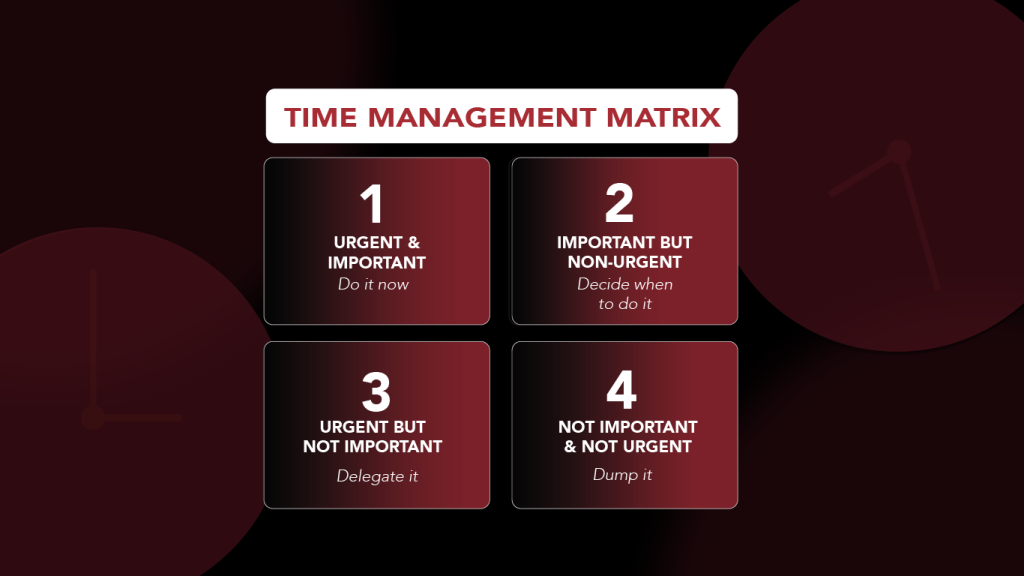With so many I.T. service companies to choose from in the Pacific Northwest, why choose Attentus? We care about our customers and we make your business our business. As the leading provider of I.T. services in Bellevue and Seattle, we provide friendly, hands-on support 24/7. And we share our expertise, so our customers understand not only the “what” but the “why” behind our technology solutions.
First, we battle the most destructive, raging fires. This includes scenarios like a customer getting locked out of their computer, encountering remote or VPN connection issues, or experiencing monitor display problems.
Then, we plan how we’ll attack other important but non-urgent tasks. [In our Help Desk department] Think of spam emails, printer issues and Move Add or a Change (MAC) requests. [In our vCIO department, think of strategic goal setting, budgeting and critical business decisions]
Our team leans on a tried-and-true framework for prioritizing responsibilities to scale our departments and deliver expert services to our customers: The Time Management Matrix popularized by Stephen Covey, author of The 7 Habits of Highly Effective People.
Using this process, we consider the urgency and importance of each task that comes our way.
Then, we act.

Quadrant 1: Firefighters
Think of our Help Desk associates as firefighters on the front lines, ready to handle our customers’ most urgent issues.
Here’s how our Help Desk process looks in action:
Playing Ticket Tennis
Unfortunately, you may be familiar with this scenario.
Your business is facing a technical issue that needs to be dealt with now. You call a support number and you’re placed on hold (cue the Jeopardy theme). Finally, someone picks up. But instead of a human ready to troubleshoot on the other end of the line, it’s an automated recording that promises a representative will call you back within 24 hours.
You wait. And wait. And wait.
No one has time to go back-and-forth playing ticket tennis.
No More Ticket Tennis:
Attentus makes it easy to schedule appointments with our IT experts using an online portal.
First, log in and file a ticket with the Help Desk. You will then be sent a link, which will prompt you to self-book your appointment. It’s that simple.
Metrics:
To ensure our Help Desk department is firing on all cylinders, we regularly analyze the following metrics to enhance efficiency and overall productivity.
Reactive Hours per Endpoint per Month (RHEM)
Our team keeps track of the number of endpoints we manage for all customers in relation to the amount of time our “firefighters”(or Help Desk agents) spend responding.
How does this look in action? Let’s say our team spent 1,000 hours “putting out fires” and providing reactive support for 5,000 customers. In this scenario, the RHEM is .2. This means that our “firefighters” spent an average of 14 minutes tending to each trouble ticket dispatched by the Help Desk.
Average Response Time
By measuring the Average Response Time, we can ensure that our Help Desk is always equipped with the knowledge and resources to tackle any unforeseen fires.
Average Resolution Time
The Average Resolution Time informs us about whether our triage process is working effectively. It helps us understand the level of competence our “firefighters” have to handle the varying issues that are dispatched to them for remediation.
Suppose a trouble ticket takes over an hour to resolve. First, the department initiates a peer review and deploys its resources to determine whether the ticket requires escalation. If it does, we use the ticket to train our employees in order to improve productivity, ultimately resulting in better resolution times in the future.
Quadrant 2: Forest Management
Our Network Administration department lives in the important but non-urgent second quadrant of the Time Management Matrix. Think of this team as “forest managers,” a dedicated team committed to preventing wildfires before they start.
The primary goal of our “forest managers” is to cultivate strong, technical relationships with our customers. They do this by providing regular proactive maintenance services and audits to identify technical risks, which minimizes the need for reactive support. This increases time and profitability for both Attentus and our customers.
Most issues that fall into this category are caused by faulty hardware, outdated software, or more commonly, user error. Our “forest managers” are dedicated to training our customers on preventative measures.
Technical Relationship
Meet our “forest managers” (or Network Administrators). Their goal is to be Subject Matter Experts (SME) on our customers’ hardware, software, cloud inventory, network inventory, configurations, line of business apps and vendor relationships.
Our “forest managers” understand the ins-and-outs of each client’s IT environment.
Rhythm of Service
Depending on the size and complexity of the IT environment, our customers can expect a visit from our “forest managers” on a monthly, quarterly or bi-annual basis. During these visits, our team performs audits and any necessary maintenance.
This rhythm enforces accountability, proper planning and hygiene to the environment. It’s a win-win for both the client and Attentus.
Proactive Maintenance and Auditing
Our “forest managers” (network administrators) take a proactive approach. They treat our customers’ business IT environments holistically, creating custom maintenance plans tailored to each client’s technology needs.
By performing regular audits, or in-depth industry standardization reviews, the “forest managers” keep tabs on each element of the environment, ensuring that everything is healthy and patched along. This includes a business’s IT security, infrastructure, hardware, software and business continuity.

Primary Purpose:
Meet our vCIOs. You can think of them as “fire safety inspectors,” here to verify that our customers’ IT environments are in adherence to the appropriate laws, codes, ordinances, regulations and standards.
Our vCIOs inspect IT systems to uncover any defective equipment. They evaluate the business’s tech evacuation strategies, ready to guide our customers through our overall strategy and compliance.
Our vCIOs’ primary goal is to build strong relationships with our customers. They do this by communicating with them regularly, keeping them up-to-date on important technology risks. They’re here to walk our customers through the budget process. They recommend necessary improvements in the tech environments, ultimately helping them reach their long-term business goals.
Business Relationship:
How does a relationship between our client and our “fire safety inspectors” (vCIOs) look in practice?
Our “inspectors” are constantly asking questions to get to the bottom of our customers’ goals and pain points. They are here to translate the business impact of settling for mis-aligned technologies to help build priorities into a long-term plan.
Above all, our “fire safety inspectors” are committed to maximizing customers’ IT investments, building trust and a strong strategy to benefit businesses as a whole.
Rhythm of Service:
Our “fire safety inspectors” (vCIOs) dedicate time on a regular basis to focus on each client’s technology needs.
Based on the size and complexity of the client’s IT environment, our inspectors perform strategic check-in meetings onsite or remotely on a quarterly, bi-annual or annual basis. This rhythm enforces accountability, proper planning, communication and hygiene in the environment.
Business Impact and Risk:
“Fire Safety Inspectors” (vCIOs) work in tandem with the “Forest Management Division” (or our Network Administrators) to translate dense, technical analyses into a simple-to-understand conversation with our customers.
This discussion outlines our goals and overall tech recommendations, bridging the communication between the entire Attentus team and the client. It allows our vCIOs to develop action items, creating projects that implement new technologies, update the IT configuration, tweak the policies or warranties or enhance services contracts.
Budgeting and Strategy:
The Attentus team is here to develop a strategic road map for each client. We do this by identifying long-term strategies and opportunities that may enhance the client’s tech environment.
Essential to this process is developing a budget that details how each client should allocate resources in order to maximize their investments in technology. We’re here to help drive clarity in our customers’ IT purchases, helping them make informed business decisions.

Primary Purpose:
Welcome to Attentus’s “fire station”: the Centralized Services Department.
This is the hub of our resources and technical agents. The primary purpose of the department is to manage all of our tools and equipment. Its goal is to equip clients with the tools they need to put out any fire.
By leveraging the resources acquired from the “fire station,” our clients can increase efficiency via standardization, automation and training.
Some examples of what happens at the “fire station”:
Tools:
Our “fire station” (or Centralized Services department) maintains all of our servers, cloud systems and 3rd party vendor relationships that encompass our tool stack.
Here’s what lives at the Attentus “fire station”
Patch management and more
Automation:
The key to driving scalability for our clients’ businesses? Automation.
By automating routes for systems, services and applications, our team optimizes clients’ IT environments so they can focus on what matters most: their mission.

The Attentus project team is dynamic and savvy. It consists of a project manager, coordinator and engineer who leverage our resources to provide the best possible outcomes for our customers.
From configuring network upgrades to migrating on-premise technology into the cloud, the project team understands how to expertly craft solutions for any IT issues.
Design Desk:
Twice a week, the Attentus Design Desk works with our customers to provide expert-level project scoping, budgeting and design services.
Procurement:
How does Attentus prioritize researching, quoting, acquiring and delivering new third party hardware, software and technical services for our customers? What’s the procurement process?
Imagine a highway. In the fast lane, we have general, easy-to-obtain technology like computers, keyboards, mice and the like. The right lane, for slower drivers, is bumper-to-bumper with more complex projects that require engineering and consistent, detailed communication with our customers.
Field Operations:
When our customers face business IT issues that must be remedied onsite, our Field Operations team are our guys. With boots on the ground, this department competes hands-on tasks to benefit the organization’s IT infrastructure as a whole.
Moves, Adds and Changes:
Moves, Adds and Changes (MACs) are tickets submitted by customers that contain either simple project requests or complex ones.

What’s the wait time? That depends on the size and scope of the project.
For a simple project, customers can expect a solution within an hour. Examples of these smaller requests include installation of new emails, apps and other software.
Complex MACs generally take more than an hour. Examples might include setting up a new computer, moving an existing user to another workstation, installing a printer on multiple workstations or physically transferring a workstation to another location within the organization.

Many small, medium and even large corporations have seen IT budgets dwindle even as IT and technology become increasingly critical to their business and customers. Even a few minutes of downtime can end up costing huge amounts of money and lost revenue.
That’s why we’ve put together a comprehensive managed IT service to help businesses thoughout the Pacific Northwest.
Here is a small list of some of the tasks that our clients rely on us for:
Contact us now to talk about if our managed IT services will provide your business with what it needs to keep you focused on the core business and not with the IT that supports your business.

Don’t get caught in that position. Take a look at our managed IT support services for your business before disaster strikes and you’ll be far better prepared. Our clients use some or all of these services:
Don’t wait! Call us now to discuss how you can benefit from our managed IT support services that will keep your Pacific Northwest business ready to grow!

Contact us at 253-455-7458 now. We also have our online form that you can use also in order to start this important conversation.
Please note: procurement and installation services are available to clients only. If you are interested in a full-service MSP provider, we’d be happy to meet with you!